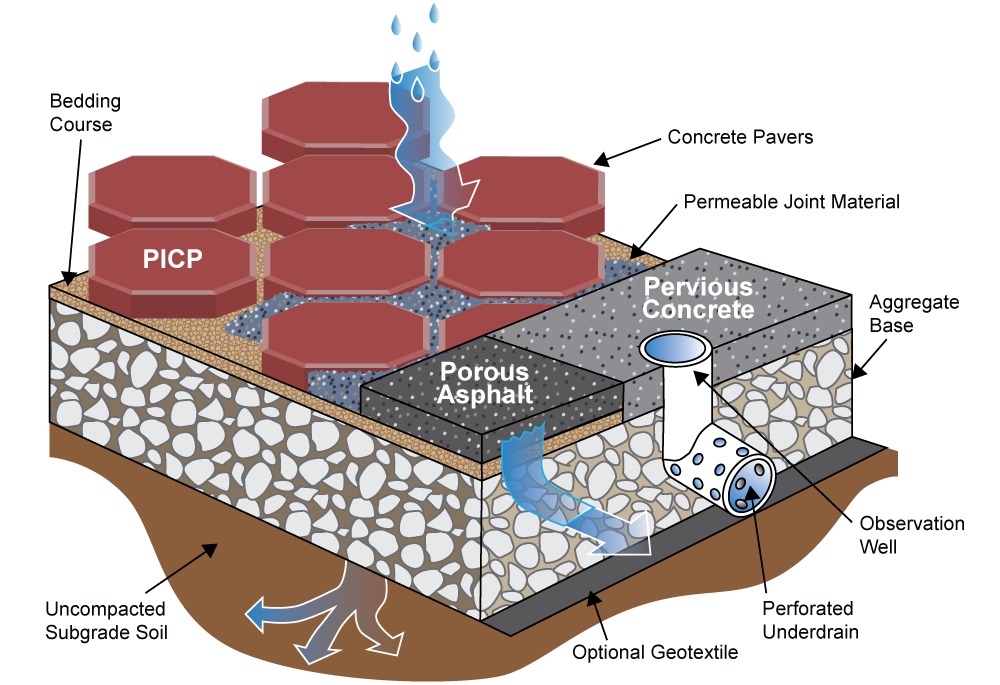 Protecting our environment, one stormwater practice at a time.
Protecting our environment, one stormwater practice at a time.
Permeable Pavement
Overview
Unlike traditional pavements, permeable pavements allow stormwater to quickly infiltrate through the surface to an underlying layer of stone. There are three main categories of permeable pavements: porous asphalt, pervious concrete and permeable interlocking concrete pavers (PICP). Most permeable pavement systems include the pavement surface, a bedding course, an open-graded aggregate base and an underdrain. Water quality and runoff reduction is achieved though adsorption, filtering, biological activity and infiltration into underlying soils or to the storm drain system.
How Permeable Pavement Works
Porous asphalt and pervious concrete use a specially designed mix of aggregate to achieve a porous and strong surface. PICP are interlocking pavers with open joints between the pavers. Although the pavers themselves are not permeable, the joints are filled with small aggregate to allow infiltration. Beneath the porous asphalt and pavers is a bedding course, or layer, of small stone which provides a level surface for installation. All permeable pavement systems include an aggregate base or stone reservoir made up of larger stones. The aggregate base layer provides temporary storage for infiltrated water and structural support for the surface and filters pollutants from runoff. Naturally occurring bacteria living in the layers helps break down pollutants. Permeable pavement systems can be designed for areas with full or partial infiltration or no infiltration. Full or partial infiltration allows captured runoff to infiltrate into underlying soils, reducing runoff.


How to Maintain Permeable Pavement
- Keep surfaces free of trash, sediment and debris
- Vacuum sweep at least twice per year
- Inspect the structural integrity of the pavement surface, looking for signs of surface deterioration such as slumping, cracking or broken pavers and replace or repair affected areas as needed
- Avoid the following on ALL permeable pavements:
- Sanding
- Re-sealing
- Re-surfacing
- Power washing
- Storing of snow piles containing sand
- Storing of mulch or soil materials

Permeable pavement types shown: Pervious concrete, PICP, Porous asphalt.
Troubleshooting Standing Water
If pavement shows signs of staining or clogging or water is ponding in the observation well for 72 hours after a half-inch rain storm, the pavement is most likely clogged due to significant sediment accumulation. Restorative vacuuming is required to achieve full functionality. After sweeping, test pavement sections by pouring a five gallon bucket of water on the surface to ensure water is infiltrating.
FairFacts
- Permeable pavement was developed by the Franklin Institute in Philadelphia in 1972 to control stormwater runoff.
- Permeable pavements are best installed in areas of light traffic with speeds of less than 35 miles per hour and limited turning operations. Examples of suitable locations are residential and commercial parking areas.
- The underlying soils, slope, proximity to groundwater and surrounding land use should be taken into consideration during design.
- Choosing light colored pavers helps reduce the urban heat island effect.
- Permeable pavements should not be installed where land use activities may generate contaminated runoff.
The information in this fact sheet is general in nature and is not intended to determine maintenance responsibility.
For more information, contact:
Department of Public Works and Environmental Services, Maintenance and Stormwater Management Division
10635 West Drive, Fairfax, VA 22030
703-877-2800, TTY 711
ContactMSMD@fairfaxcounty.gov

